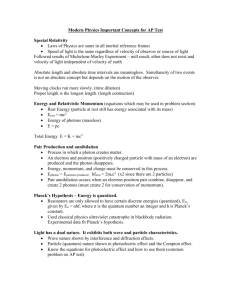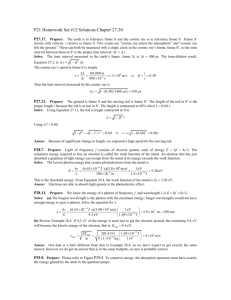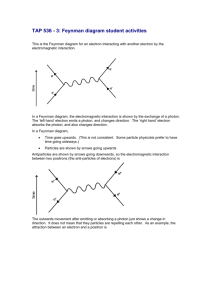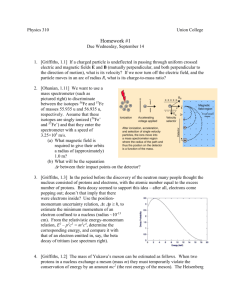Option B Problem Set Answer Key
advertisement
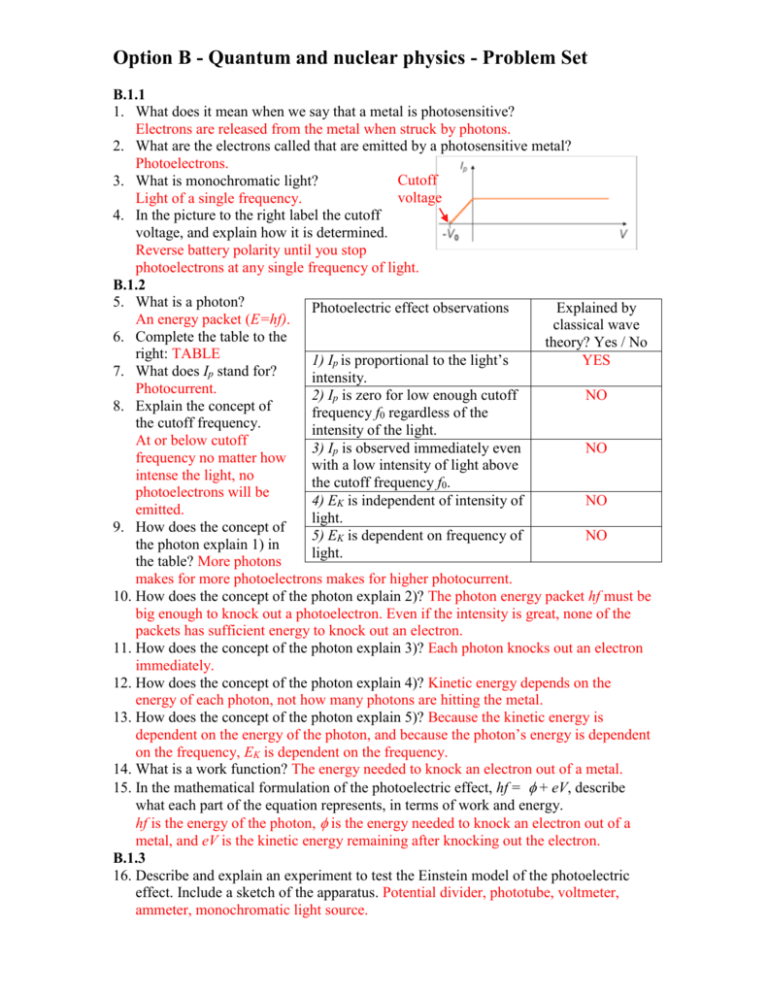
Option B - Quantum and nuclear physics - Problem Set B.1.1 1. What does it mean when we say that a metal is photosensitive? Electrons are released from the metal when struck by photons. 2. What are the electrons called that are emitted by a photosensitive metal? Photoelectrons. Cutoff 3. What is monochromatic light? voltage Light of a single frequency. 4. In the picture to the right label the cutoff voltage, and explain how it is determined. Reverse battery polarity until you stop photoelectrons at any single frequency of light. B.1.2 5. What is a photon? Photoelectric effect observations Explained by An energy packet (E=hf). classical wave 6. Complete the table to the theory? Yes / No right: TABLE 1) Ip is proportional to the light’s YES 7. What does Ip stand for? intensity. Photocurrent. 2) Ip is zero for low enough cutoff NO 8. Explain the concept of frequency f0 regardless of the the cutoff frequency. intensity of the light. At or below cutoff 3) Ip is observed immediately even NO frequency no matter how with a low intensity of light above intense the light, no the cutoff frequency f0. photoelectrons will be 4) EK is independent of intensity of NO emitted. light. 9. How does the concept of 5) EK is dependent on frequency of NO the photon explain 1) in light. the table? More photons makes for more photoelectrons makes for higher photocurrent. 10. How does the concept of the photon explain 2)? The photon energy packet hf must be big enough to knock out a photoelectron. Even if the intensity is great, none of the packets has sufficient energy to knock out an electron. 11. How does the concept of the photon explain 3)? Each photon knocks out an electron immediately. 12. How does the concept of the photon explain 4)? Kinetic energy depends on the energy of each photon, not how many photons are hitting the metal. 13. How does the concept of the photon explain 5)? Because the kinetic energy is dependent on the energy of the photon, and because the photon’s energy is dependent on the frequency, EK is dependent on the frequency. 14. What is a work function? The energy needed to knock an electron out of a metal. 15. In the mathematical formulation of the photoelectric effect, hf = + eV, describe what each part of the equation represents, in terms of work and energy. hf is the energy of the photon, is the energy needed to knock an electron out of a metal, and eV is the kinetic energy remaining after knocking out the electron. B.1.3 16. Describe and explain an experiment to test the Einstein model of the photoelectric effect. Include a sketch of the apparatus. Potential divider, phototube, voltmeter, ammeter, monochromatic light source. Option B - Quantum and nuclear physics - Problem Set B.1.4 17. A photosensitive metal has a work function of 3.75 eV. Find the minimum frequency of light needed to free an electron from its surface. hf = = 3.75(1.610-19) = 610-19. 6.6310-34f = 610-19. f = 9.041014 Hz. 18. If a photon having a higher frequency than the one determined in the previous problem strikes the metal, where will the excess energy go? EK. 19. A photosensitive metal has a work function of 3.75 eV. Find the maximum kinetic energy of an electron freed by a photon having a frequency of 2.51015 Hz. = 610-19. hf = 6.6310-34(2.51015) = 1.6610-18. eV = hf - = 1.0610-18 J. B.1.5 20. What is meant by the term “wave-particle duality” and to what is it applied? Matter and energy can both act like waves and act like particles. 21. What is a matter wave? It is the wave part of the duality manifest in matter. = h/p. 22. State the de Broglie hypothesis, and then write its mathematical formula. Matter will have a wavelength given by = h/p. B.1.6 23. Present an outline of the Davisson-Germer experiment and how it verified the de Broglie hypothesis. Electron beam fired through crystalline structure showed electrons’ diffraction as per = h/p. B.1.7 24. An electron is accelerated from rest through a potential difference of 275 V. What is its expected de Broglie wavelength? EK =eV = (1.610-19)(275) = 4.410-17 J = p2/2m. p= sqr[2(9.1110-31)(4.410-17)] = 8.9510-24. = h/p= 6.6310-34/8.9510-24 = 7.410-11m. 25. A particle has an energy E and an associated de Broglie wavelength . Show that the energy E is proportional to -2. E = p2/2m but p = h/ so that E = h2/2m2. B.1.8 26. Outline a laboratory procedure for producing and observing atomic spectra. Gas discharge tube and spectroscope. B.1.9 27. Explain how atomic spectra provide evidence for the quantization of energy in atoms. Discrete energy bands observed in the spectra. B.1.10 28. What is the frequency of a 656 nm hydrogen emission spectrum line? c=f so that f=c/ = 3108/65610-9 = 4.571014 Hz. 29. What is the energy in J and eV of the photon from 1)? E=hf=(6.6310-34)(4.571014) = 3.0310-19 J = 1.89eV. 30. What are the energy levels associated with this photon? 3.40-1.51=1.89. e- jumps from n = 3 to n = 2. B.1.11 31. Show that the allowed kinetic energies of an electron that resonates in a box of length L is given by EK = n2h2/[8mL2]. See attachment. Option B - Quantum and nuclear physics - Problem Set B.1.12 32. Write Schrödinger’s wave equation here, and talk about its parts, in terms of kinetic, potential, and total energy. (EK + EP) = E. 33. How is Schrödinger’s wave equation similar to the electron in the box equation you derived in 31)? How is it different? “electron in a box” EK = n2h2/[8mL2], Schrödinger’s EK = n2h2/[8m2]. 34. How do the electron orbitals in the Schrödinger model differ from those in the Bohr model? Schrödinger: very complex; Bohr: circles. 35. List the four quantum numbers of the Schrödinger model. n, l, ml, and ms 36. Make an organized table of all of the allowed quantum states for energy level n = 3. Then label them s, p, and d. How many allowed states are there? See attachment. 37. What is the meaning of Pauli’s exclusion principle and how did you use it to complete your table in 36)? No two electrons may have all identical four quantum numbers. Limited the number of allowed states. B.1.13 38. In general words, what do the two forms of the Heisenberg uncertainty principle say? If the position is known, the momentum isn’t (and vice versa). If the energy is known, the time isn’t (and vice versa). 39. An electron and a jet fighter are observed to have equal speeds of 400 m/s, accurate to within 0.020%. What is the minimum uncertainty in the position of each if the mass of the jet is 750 kg? ∆v = .0002(400) = 0.08 ms-1. ∆x=h/[4m∆v]. For fighter ∆x=(6.6310-34)/[4(750)(0.08)] = 8.7910-37 m. For electron ∆x=(6.6310-34)/[4(9.1110-31)(0.08)] = 7.2410-4 m. 40. An electron in an excited state has a lifetime of 2.7510-8 seconds before it deexcites. (a) What is the minimum uncertainty in the energy of the photon emitted on deexcitation? ∆E = h/[4∆t] = (6.6310-34)/[4(2.7510-8)] = 1.9210-27 J. (b) What is the magnitude in the broadening of the frequency of the spectral line? ∆E = h∆f so that ∆f = ∆E/h = 1.9210-27/6.6310-34 = 2.89106 Hz. B.2.1 41. Explain how the radii of nuclei may be estimated from charged particle scattering experiments. The work-kinetic energy theorem and the Coulomb potential. B.2.2 42. Describe how the masses of nuclei may be determined using a Bainbridge mass spectrometer. A magnetic field causes charged isotopes to follow circular trajectories. The heavier the isotope, the bigger the radius. B.2.3 43. Describe one piece of evidence for the existence of nuclear energy levels. The gamma decay of excited nuclei. B.2.4 44. Describe beta plus (+) decay including the existence of the neutrino. Compare this to the beta minus (-) decay we learned about previously. A proton decays into a neutron and a + particle and a neutrino (to allow for varied EK of the +). - has a neutron decay into a proton and an electron. Option B - Quantum and nuclear physics - Problem Set B.2.5 45. State the radioactive decay law as an exponential function and define the decay constant. N = Noe-t where is the decay constant. The decay constant is the probability of decay of a nucleus per unit time. B.2.6 46. Derive the relationship between decay constant and half-life. See attachment. B.2.7 47. Outline methods for measuring the half-life of an isotope. Use a Geiger counter to measure the activity of a sample at different times. Activity is proportional to the remaining population. B.2.8 48. The half-life of a radioactive nuclide 4.5109 y. Find its decay constant. T1/2 = ln 2 / so that = ln 2 / T1/2 = ln 2 / 4.5109 y = 1.510-10 y-1. 49. In words, what is the decay constant of a nuclide? The decay constant is the probability of decay of a nucleus per unit time. 50. Decay rates are measured with a ________ and are measured in ________. Geiger-Mueller counter / Becquerels, or decays per second. 51. Why is the decay rate A proportional to the population of nuclides N? Because the more nuclides you have, the more decays you will have. 52. The activity per gram of a radioactive isotope is 7.8 disintegrations per hour at t = 0 h 5.6 disintegrations per hour at t = 8.2 h. Find the decay constant of this isotope. N = Noe-t so that A = Aoe-t . From A = 7.8 at t = 0 we see that A0 = 7.8. Then 5.6 = 7.8 e- 8.2 0.7179 = e- 8.2 ln(0.7179) = -8.2 -0.331 = -8.2 = 0.04 h-1. 53. Find the half-life of this isotope. T1/2 = ln 2 / = ln 2 / 0.04 h-1 = 17 h. 54. Find the activity per gram of the isotope of 52) at t = 10 h. A = 7.8 e- 10 = 7.8 e-(0.04) 10 = 5.22 disintegrations per hour. Option B - Quantum and nuclear physics - Problem Set ATTACHMENTS: 31. Show that the allowed kinetic energies of an electron that resonates in a box of length L is given by EK = n2h2/[8mL2]. 1 = 2L = 2L/n. = h/p = h/mv so that v = h/m = nh/[2mL]. 2 = 2L 2 2 2 2 2 Then EK = (1/2)mv = (1/2)m[n h /4m L ]. 3 = 2L 2 2 2 Finally, EK = n h /(8mL ). L 36. Make an organized table of all of the allowed quantum states for energy level n = 3. Then label them s, p, and d. How many allowed states are there? n = 1,2,3 l = 0,...n-1 ml = 0, 1, 2, , l ms = ½ n l ml ms n l ml ms 1s 0 0 1/2 3s 0 0 1/2 1s 0 0 -1/2 3s 0 0 -1/2 2s 0 0 1/2 3p 1 -1 1/2 2s 0 0 -1/2 3p 1 -1 -1/2 2p 1 -1 1/2 3p 1 0 1/2 2p 1 -1 -1/2 3p 1 0 -1/2 2p 1 0 1/2 3p 1 1 1/2 2p 1 0 -1/2 3p 1 1 -1/2 2p 1 1 1/2 3d 2 -2 1/2 2p 1 1 -1/2 3d 2 -2 -1/2 3d 2 -1 1/2 3d 2 -1 -1/2 3d 2 0 1/2 3d 2 0 -1/2 3d 2 1 1/2 3d 2 1 -1/2 3d 2 2 1/2 3d 2 2 -1/2 46. Derive the relationship between decay constant and half-life. N = Noe-t N0/2 = Noe-T (1/2) = e-T ln(1/2) = -T1/2 -ln(1/2) = T1/2 ln 2 = T1/2 T1/2 = ln 2 /

